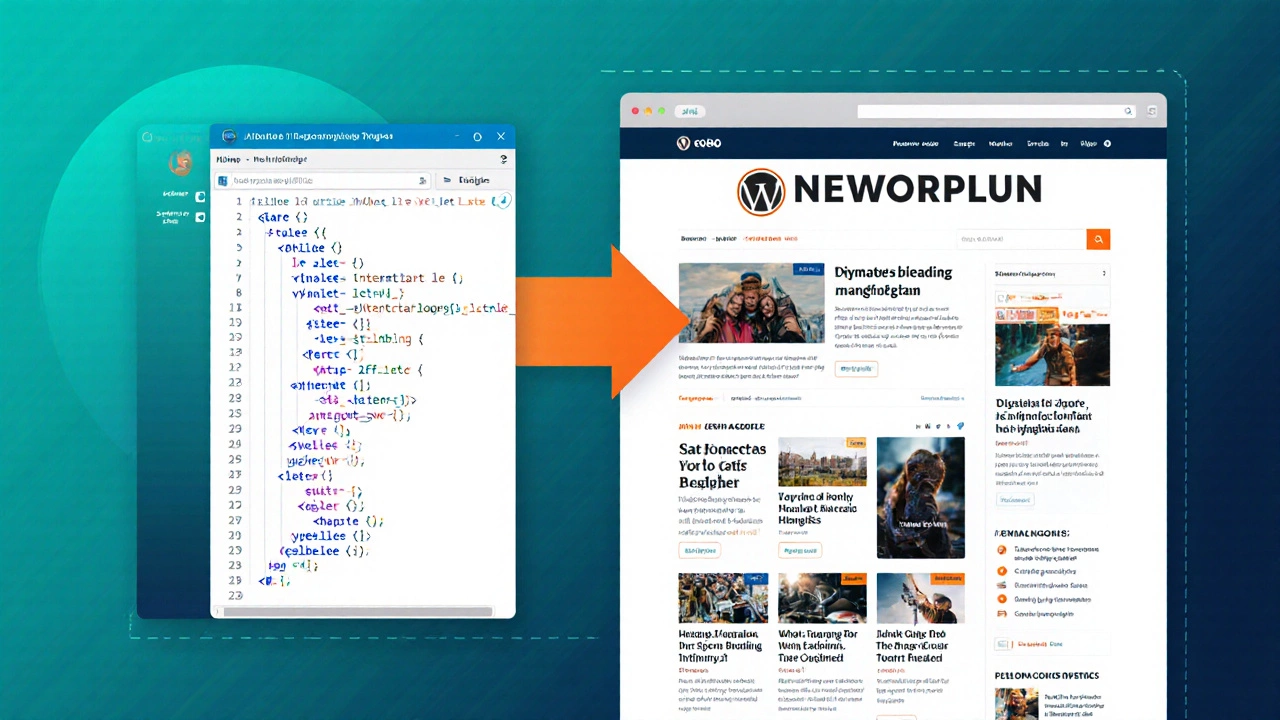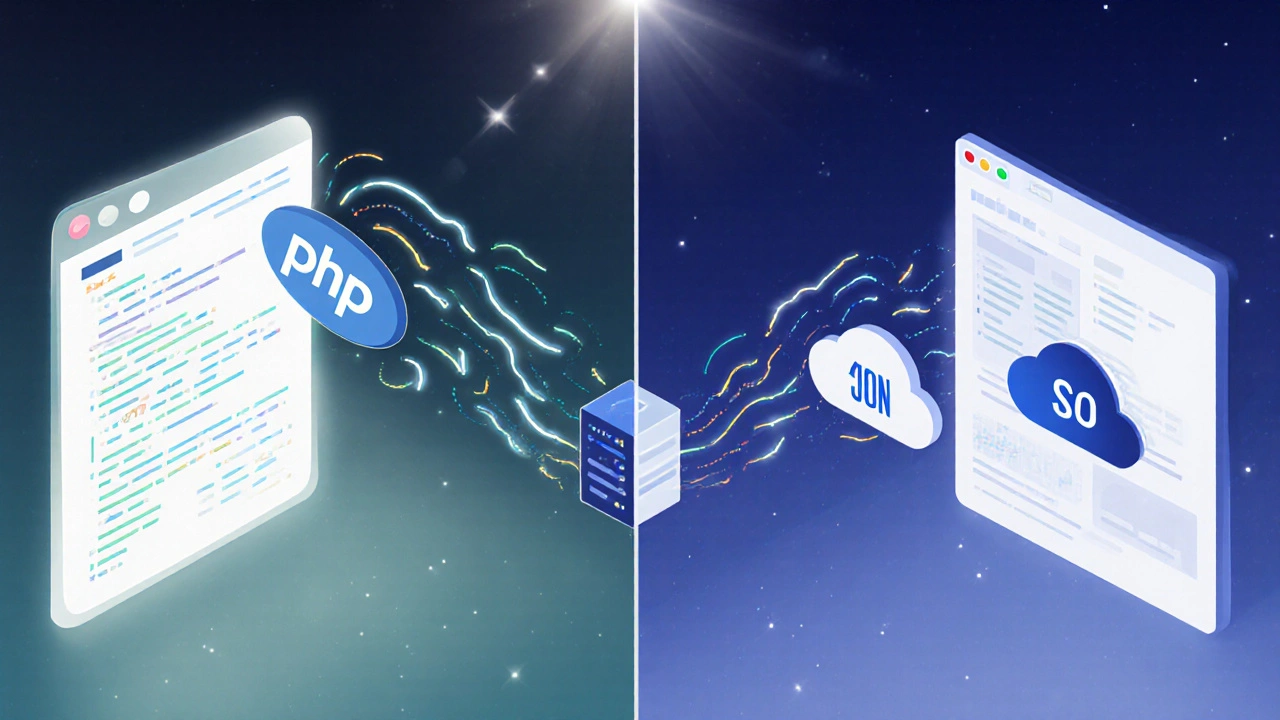When you hear "front end," you probably picture HTML, CSS, and JavaScript dancing together in the browser. PHP usually lives on the server, handling form submissions, database queries, and business logic. But the line between client and server isn’t a hard wall - developers often blend the two to save time, improve performance, or fit a legacy stack. This guide walks through exactly how PHP can show up in front‑end work, when it makes sense, and what pitfalls to watch out for.
What front‑end development really means
Front‑end development is the practice of building the visual and interactive parts of a website that run inside the user’s browser. It relies on three core technologies:
- HTML defines the page structure.
- CSS styles that structure.
- JavaScript adds interactivity and dynamic behaviour.
The front‑end’s job is to turn raw data into a polished user experience, handling things like layout, animations, form validation, and API calls.
What PHP actually does
PHP (Hypertext Preprocessor) is a server‑side scripting language designed to generate HTML (or other text) before it reaches the browser. It excels at accessing databases, managing sessions, and producing dynamic pages on the fly.
Typical PHP workflows include:
- Fetching rows from MySQL and looping over them to build a table.
- Processing a form, validating input, then redirecting or re‑rendering the page with error messages.
- Serving JSON for a front‑end REST API endpoint, which JavaScript can consume.
How PHP reaches the front end
Even though PHP runs on the server, it can influence the front end in three main ways:
- Server‑side rendering (SSR): PHP builds complete HTML pages and sends them to the browser. The browser sees a fully rendered page, no extra JavaScript needed for the initial view.
- Template engines: Tools like
Twig,Blade(Laravel), or the classic PHP template syntax let you mix PHP variables with HTML tags. The result is still plain HTML that the browser understands. - API responses: PHP can output JSON or XML that JavaScript fetches via AJAX calls. The front‑end then updates the DOM based on that data.
In practice, most modern sites combine SSR for the first paint and AJAX for subsequent updates.

Typical scenarios where PHP powers the front end
Here are the most common patterns you’ll encounter in the wild:
- Content‑heavy sites: News portals, blogs, and e‑commerce catalogs often generate page markup with PHP because the content is stored in a database and changes frequently.
- WordPress themes: WordPress, the biggest CMS on the planet, uses PHP templates to render posts, menus, and widgets. Front‑end developers customizing a theme are actually writing PHP mixed with HTML.
- Form‑driven applications: Contact forms, login pages, and checkout flows frequently post data to a PHP script that validates input and re‑displays the form with error messages.
- Hybrid SPA setups: Frameworks like React or Vue can be bootstrapped with a PHP‑generated
index.phpthat injects initial data via a<script>tag. This avoids an extra round‑trip for the first data set.
Pros and cons of using PHP for front‑end tasks
Every technology comes with trade‑offs. Below is a quick rundown to help you decide.
| Aspect | Pros | Cons |
|---|---|---|
| Performance (first paint) | SSR delivers a fully rendered page, so users see content instantly. | Every request hits the server; high traffic can cause bottlenecks. |
| Developer familiarity | Lots of PHP‑based CMSs and hosting options make onboarding easy. | Front‑end teams may need to learn basic PHP syntax, slowing them down. |
| SEO friendliness | Search engines crawl rendered HTML directly, avoiding JavaScript rendering issues. | Dynamic client‑side features still need JavaScript, creating a mixed codebase. |
| Maintainability | Separation of template and logic (using Twig/Blade) keeps code tidy. | Mixing PHP into HTML can become messy if conventions are ignored. |
| Scalability | Stateless PHP scripts work well with load balancers and caching layers. | Stateful sessions stored on the server can limit horizontal scaling. |
Alternatives and when they shine
If you’re debating whether to reach for PHP or stick to a pure JavaScript stack, consider these options:
- Node.js + Express: Ideal for teams already deep in JavaScript. You can serve both API and server‑rendered pages with the same language.
- Static site generators (Gatsby, Hugo): Perfect when content rarely changes and you want lightning‑fast loads from a CDN.
- Headless CMS (Contentful, Strapi): Stores content centrally and serves JSON; the front end can be any framework while the back end stays language‑agnostic.
- Server‑side frameworks like Laravel or Symfony: If you love PHP but need more structure, these frameworks provide routing, ORM, and testing tools that keep large projects organized.
Pick the tool that matches your team’s skill set, performance goals, and long‑term maintenance plan.

Decision checklist: Should you use PHP for front‑end rendering?
- Is your project already built on a PHP‑driven CMS (WordPress, Drupal) or framework (Laravel)? If yes, reuse the existing templating system.
- Do you need fast first‑paint SEO‑friendly HTML? Server‑side rendering with PHP can be simpler than client‑side hydration.
- Are you comfortable maintaining a mixed PHP/HTML codebase? If your front‑end team prefers pure JavaScript, the overhead may outweigh benefits.
- Will you serve a high volume of identical pages that can be cached? Combine PHP with a reverse proxy (Varnish, Cloudflare) to mitigate performance hits.
- Do you plan to evolve toward a headless architecture? Start with PHP APIs and gradually replace the front end with a SPA.
If the majority of answers point to “yes,” PHP is a solid choice. If you’re stuck on the cons, explore the alternatives above.
Mini FAQ - answering the most common follow‑ups
Can PHP replace JavaScript on the front end?
No. PHP runs on the server, so it can generate HTML and JSON, but it cannot manipulate the DOM after the page loads. For interactive features you still need JavaScript on the client side.
Is it safe to embed PHP code directly in HTML files?
It’s safe as long as you follow best practices: escape output, use prepared statements for database queries, and keep business logic out of the template layer. Modern frameworks encourage a clear separation between controller logic and view files.
How does PHP work with AJAX?
A JavaScript fetch() or XMLHttpRequest call hits a PHP endpoint that returns JSON. The front‑end script parses the response and updates the page without a full reload. This pattern is very common for forms, infinite scroll, and live search.
Do modern PHP frameworks support component‑based front‑end development?
Yes. Laravel Livewire and Symfony UX let you write UI components in PHP that automatically sync with JavaScript under the hood, giving you a "single‑language" experience.
What caching strategies work best with PHP‑rendered pages?
Page‑level caching with Varnish, Nginx fastcgi_cache, or a CDN can store the fully rendered HTML for thousands of requests. For dynamic fragments, use fragment caching (e.g., Laravel’s @cache directive) or client‑side caching via HTTP headers.
Wrapping up
Front‑end development isn’t confined to a single language. While JavaScript dominates the browser, PHP remains a powerful ally for generating markup, feeding data through APIs, and keeping SEO‑friendly pages lightweight. By weighing the pros, cons, and alternatives, you can decide whether PHP fits your project’s front‑end strategy or if you should head toward a pure JavaScript or headless approach.



